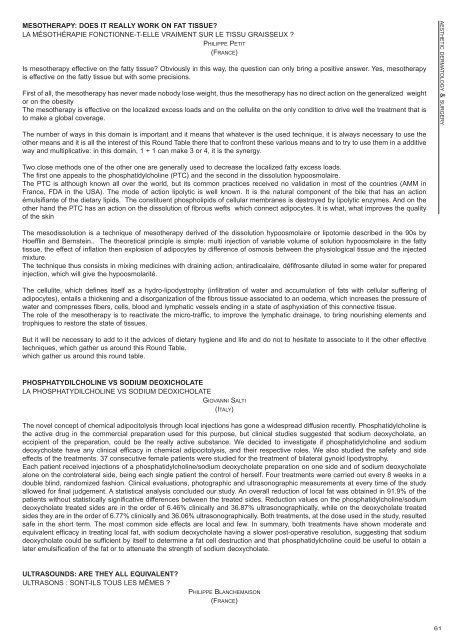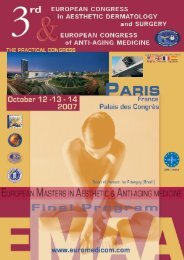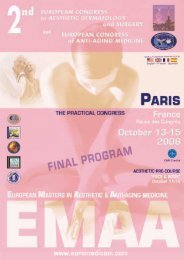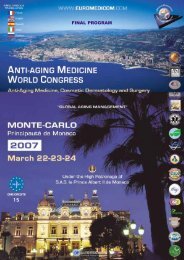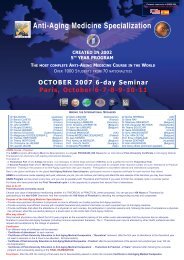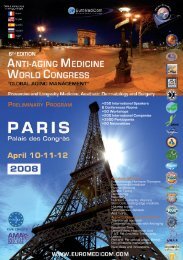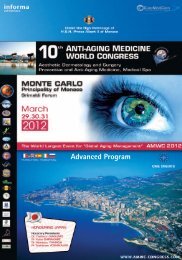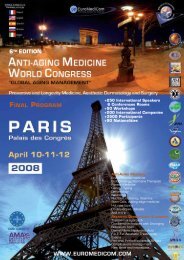FINAL PROGRAM 6TH EDITION - EuroMediCom
FINAL PROGRAM 6TH EDITION - EuroMediCom
FINAL PROGRAM 6TH EDITION - EuroMediCom
You also want an ePaper? Increase the reach of your titles
YUMPU automatically turns print PDFs into web optimized ePapers that Google loves.
MESOTHERAPY: DOES IT REALLY WORK ON FAT TISSUE?LA MÉSOTHÉRAPIE FONCTIONNE-T-ELLE VRAIMENT SUR LE TISSU GRAISSEUX ?PHILIPPE PETIT(FRANCE)Is mesotherapy effective on the fatty tissue? Obviously in this way, the question can only bring a positive answer. Yes, mesotherapyis effective on the fatty tissue but with some precisions.First of all, the mesotherapy has never made nobody lose weight, thus the mesotherapy has no direct action on the generalized weightor on the obesityThe mesotherapy is effective on the localized excess loads and on the cellulite on the only condition to drive well the treatment that isto make a global coverage.The number of ways in this domain is important and it means that whatever is the used technique, it is always necessary to use theother means and it is all the interest of this Round Table there that to confront these various means and to try to use them in a additiveway and multiplicative: in this domain, 1 + 1 can make 3 or 4, it is the synergy.AESTHETIC DERMATOLOGY & SURGERYTwo close methods one of the other one are generally used to decrease the localized fatty excess loads.The first one appeals to the phosphatidylcholine (PTC) and the second in the dissolution hypoosmolaire.The PTC is although known all over the world, but its common practices received no validation in most of the countries (AMM inFrance, FDA in the USA). The mode of action lipolytic is well known. It is the natural component of the bile that has an actionémulsifiante of the dietary lipids. The constituent phospholipids of cellular membranes is destroyed by lipolytic enzymes. And on theother hand the PTC has an action on the dissolution of fibrous wefts which connect adipocytes. It is what, what improves the qualityof the skinThe mesodissolution is a technique of mesotherapy derived of the dissolution hypoosmolaire or lipotomie described in the 90s byHoefflin and Bernstein.. The theoretical principle is simple: multi injection of variable volume of solution hypoosmolaire in the fattytissue, the effect of inflation then explosion of adipocytes by difference of osmosis between the physiological tissue and the injectedmixture.The technique thus consists in mixing medicines with draining action, antiradicalaire, défifrosante diluted in some water for preparedinjection, which will give the hypoosmolarité.The cellulite, which defines itself as a hydro-lipodystrophy (infiltration of water and accumulation of fats with cellular suffering ofadipocytes), entails a thickening and a disorganization of the fibrous tissue associated to an oedema, which increases the pressure ofwater and compresses fibers, cells, blood and lymphatic vessels ending in a state of asphyxiation of this connective tissue.The role of the mesotherapy is to reactivate the micro-traffic, to improve the lymphatic drainage, to bring nourishing elements andtrophiques to restore the state of tissues.But it will be necessary to add to it the advices of dietary hygiene and life and do not to hesitate to associate to it the other effectivetechniques, which gather us around this Round Table.which gather us around this round table.PHOSPHATYDILCHOLINE VS SODIUM DEOXICHOLATELA PHOSPHATYDILCHOLINE VS SODIUM DEOXICHOLATEGIOVANNI SALTI(ITALY)The novel concept of chemical adipocitolysis through local injections has gone a widespread diffusion recently. Phosphatidylcholine isthe active drug in the commercial preparation used for this purpose, but clinical studies suggested that sodium deoxycholate, aneccipient of the preparation, could be the really active substance. We decided to investigate if phosphatidylcholine and sodiumdeoxycholate have any clinical efficacy in chemical adipocitolysis, and their respective roles. We also studied the safety and sideeffects of the treatments. 37 consecutive female patients were studied for the treatment of bilateral gynoid lipodystrophy.Each patient received injections of a phosphatidylcholine/sodium deoxycholate preparation on one side and of sodium deoxycholatealone on the controlateral side, being each single patient the control of herself. Four treatments were carried out every 8 weeks in adouble blind, randomized fashion. Clinical evaluations, photographic and ultrasonographic measurements at every time of the studyallowed for final judgement. A statistical analysis concluded our study. An overall reduction of local fat was obtained in 91.9% of thepatients without statistically significative differences between the treated sides. Reduction values on the phosphatidylcholine/sodiumdeoxycholate treated sides are in the order of 6.46% clinically and 36.87% ultrasonographically, while on the deoxycholate treatedsides they are in the order of 6.77% clinically and 36.06% ultrasonographically. Both treatments, at the dose used in the study, resultedsafe in the short term. The most common side effects are local and few. In summary, both treatments have shown moderate andequivalent efficacy in treating local fat, with sodium deoxycholate having a slower post-operative resolution, suggesting that sodiumdeoxycholate could be sufficient by itself to determine a fat cell destruction and that phosphatidylcholine could be useful to obtain alater emulsification of the fat or to attenuate the strength of sodium deoxycholate.ULTRASOUNDS: ARE THEY ALL EQUIVALENT?ULTRASONS : SONT-ILS TOUS LES MÊMES ?PHILIPPE BLANCHEMAISON(FRANCE)61


